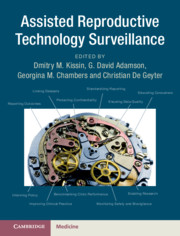Book contents
- Frontmatter
- Contents
- Foreword
- List of Contributors
- Section 1 Introduction to ART Surveillance
- 1 Infertility and ART
- 2 Importance and History of ART Surveillance
- Section 2 General Principles of ART Surveillance
- Section 3 Using ART Surveillance Data
- Section 4 Global Variations in ART Surveillance
- Section 5 Surveillance of Non-ART Fertility Treatments
- Appendix A ART Surveillance System Variables and Definitions
- Appendix B International Glossary on Infertility and Fertility Care
- Appendix C ICMART Data Collection Form
- Index
- Plates
2 - Importance and History of ART Surveillance
from Section 1 - Introduction to ART Surveillance
Published online by Cambridge University Press: 14 June 2019
- Frontmatter
- Contents
- Foreword
- List of Contributors
- Section 1 Introduction to ART Surveillance
- 1 Infertility and ART
- 2 Importance and History of ART Surveillance
- Section 2 General Principles of ART Surveillance
- Section 3 Using ART Surveillance Data
- Section 4 Global Variations in ART Surveillance
- Section 5 Surveillance of Non-ART Fertility Treatments
- Appendix A ART Surveillance System Variables and Definitions
- Appendix B International Glossary on Infertility and Fertility Care
- Appendix C ICMART Data Collection Form
- Index
- Plates
Summary
After the first successes of ART, this technique showed a rapid development, in many countries. It soon appeared to the professionals themselves that a number of important health concerns were related to the new technique, in terms of practice, efficacy and safety. Moreover, the competition between centers requested solid data for the public and health authorities correct knowledge, based on large samples. This resulted in the development of national, regional, and world registries. It needed general agreements on definitions, numerators, denominators, ways of reporting, that were obtained through several workshops that included WHO. This chapter outlines, in a first section, general importance of surveillance, on efficacy, and safety (immediate and long term, women and children). The second section describes the history itself, from national to regional and world (ICMART) registries. It shows that a lot has already been done, even if efforts are still needed to improve quality, but it is better to have insufficient knowledge than none at all.
- Type
- Chapter
- Information
- Assisted Reproductive Technology Surveillance , pp. 12 - 22Publisher: Cambridge University PressPrint publication year: 2019



